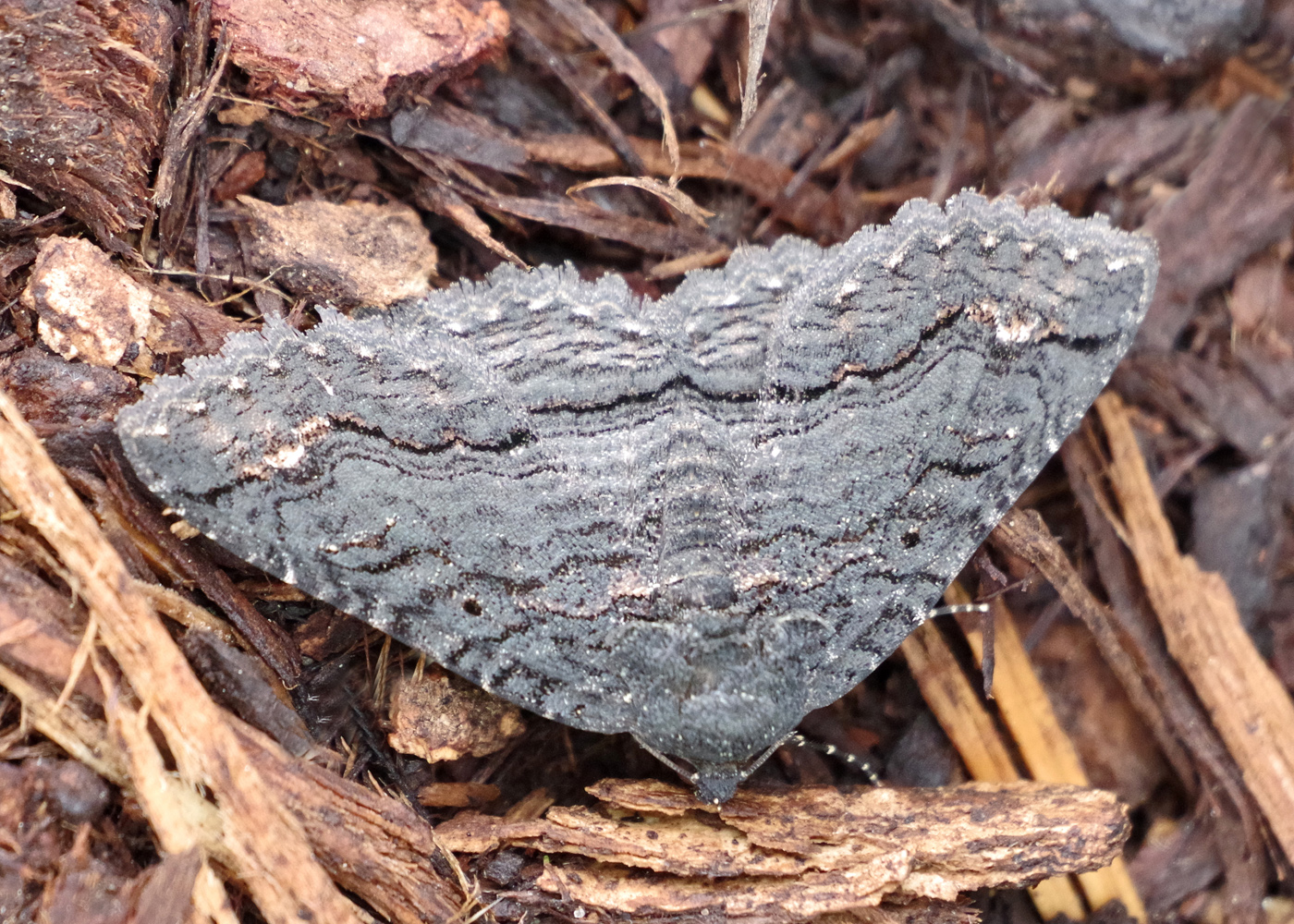
by Kate Redmond
Bug o’the Week Black Zale Moth
Greetings, BugFans,
Zale moths (thank goodness) are not small and grayish (the moth equivalent of LBJ’s – “little brown jobs” – the birding acronym for the sparrow group), and thus they are not destined to languish unidentified in the BugLady’s “X-files” for too long They’re in the moth family Erebidae (from the Latin “erebus,” meaning “from the darkness”), which contains lots of colorful and familiar groups, like the Underwings, Tiger moths, Tussock and Lichen moths, and Zales. It also includes the BugLady’s personal nemesis moth, the Black Witch https://uwm.edu/field-station/bug-of-the-week/black-witch-moth/, one of which may have flown past her house this summer while the BugLady was inside, spotted by a guest who later asked “what kind of moth is big, dark, and kind of tattered-looking?”
Pronounced “ZAH’ lay,” the genus contains almost 40 species in North America. Adults have wingspreads between 1 ½” and 2,” with wings that are camouflaged and at the same time are often strikingly patterned and even iridescent https://bugguide.net/node/view/1713943/bgimage, https://bugguide.net/node/view/647825/bgimage, https://bugguide.net/node/view/2080306/bgimage,
https://bugguide.net/node/view/1731967/bgimage. And, of course, their wings have those neat little scallops on the edges. Zale moths are nocturnal, with paired hearing organs on the thorax that allow them to detect the calls of hunting bats.
Wagner’s Caterpillars of Eastern North America calls the Zales “a large and taxonomically challenging genus.”
Female Zales lay about 200 eggs that hatch in a few weeks, spend a month as caterpillars, and live less than a month as adults. Bugguide.net describes Zale caterpillars as “exceptionally muscular …. capable of hurling themselves from their perch when alarmed.” They feed on young leaves by night – some species eat deciduous leaves, and others prefer conifer needles. Wagner, et al, in Owlet Caterpillars of Eastern North America, says that caterpillars of some species “are leaf clippers that chew through the petiole, dropping any evidence of feeding activity to the forest floor; the chewed leaves might otherwise be used by birds to locate caterpillars.” With a few notable exceptions, like the Okefenokee Zale https://bugguide.net/node/view/2108403/bgpage, the caterpillars are pretty drab and twig-like.
BLACK ZALES (Zale undularis) are found near their host plants – Black locust and Honey locusts. One source speculated that as Black locust has spread from its original range, the Black Zale has followed it.
Brief Aside: Black locust is a native species that is considered invasive outside its original range, including in Wisconsin. Wikipedia tells us that “The exact native range is not known…….The native range is thought to be two separate populations, one centered about the Appalachian Mountains, from Pennsylvania to northern Georgia, and a second westward focused around the Ozark Plateau and Ouachita Mountains of Arkansas, Oklahoma, and Missouri.“ Whatever its native range, Black locust has been planted extensively throughout the country.
Although it’s a valuable wildlife plant (hosting, among other things, 67 species of Lepidoptera, while providing cover and seeds for other animals), it has a bad habit of taking over and turning grassland habitats into shady ones (it’s a pioneer – a sun-loving species that produces enough shade for mid-tolerant woody species to establish themselves). The roots of the BugLady’s big locusts are holding the dune together, so she has a moral dilemma.
Another Brief Aside: The moth was photographed on a layer of wood chips that covers a huge piece of cardboard that covers a nasty, aggressive, persistent ground cover plant called Bishop’s weed (Aegopodium podagraria), aka goutweed, snow-on-the-mountain (a version of Bishop’s weed that has variegated leaves), and a bunch of names that have four letters. The BugLady’s minions have been fighting it for a few years with fire, vinegar, and now cardboard. If you don’t have bishop’s weed, don’t plant it, no matter what the nursery folks say, and if you’ve successfully gotten rid of it (without nuking it with chemicals), please tell the BugLady how.
OK – Back to bugs.
Like most of the Zales, Black Zales are eastern(-ish) moths; buggude.net says that they’re found from Manitoba and Minnesota to New Brunswick, south to Florida and Arkansas. And, like most of the Zales, Black Zales can show a lot of variation in color and pattern https://bugguide.net/node/view/323477/bgimage,
Adults are mainly seen in the first half of summer, though they can be hard to find when they’re sitting on a tree trunk https://bugguide.net/node/view/1204274/bgimage, and caterpillars can be hard to spot at all https://mothphotographersgroup.msstate.edu/species.php?hodges=8695, especially when they’re feeding on the undersides of leaves. They overwinter on the ground as pupae, in leaf litter.
Wagner, in Caterpillars of Eastern North America, says that “Zale caterpillars are highly mobile as first instars, often wandering long distances before they begin feeding. Most prefer young leaf tissue, especially in early instars, then consume older leaves and needles in late instars.”
Don’t let the nursery folks sell you Black locusts, either.
Kate Redmond, The BugLady
Bug of the Week archives:
http://uwm.edu/field-station/category/bug-of-the-week/
